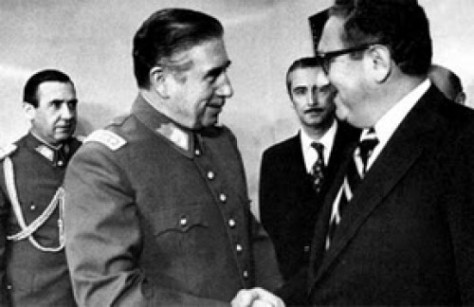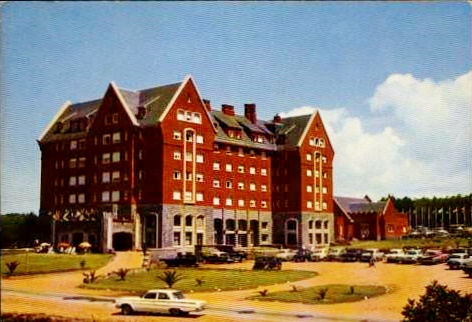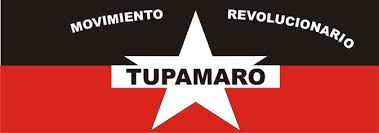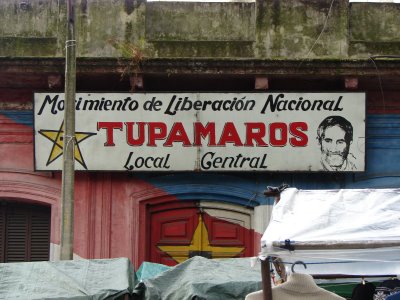.
.
In March 1985, after the restoration of democracy in Uruguay, a law was passed granting amnesty to people who had been prosecuted by the dictatorship due to ideological reasons. The Tupamaro prisoners were set free under this law that covered political and related military crimes committed since 1962.

Raúl Sendic and José Mujica were released after imprisonment for over 14 years.
The MLN-T publicly renounced armed struggle and committed itself to left-wing parliamentary politics.
When academic freedom and university autonomy were restored in 1985, student organizations, repressed during the military regime, reestablished themselves. Several professors, dismissed for ideological reasons during the repression, were allowed to return to their posts.
During the late 1980s, labor unions and labor activists, targets of repression under the military regime resumed their labor activities leading to several labor actions and strikes that caused localized disruption of day-to-day activities.
Almost all labor grievances were resolved quickly, and none of the labor actions and strikes led to serious violence. In 1986, during a strike by the staff of the state-owned Administración Nacional de Combustibles, Alcohol, y Portland (ANCAP), the military stepped in to ensure distribution of fuel, but did not act in a law enforcement capacity.
During the late 1980s, human rights groups – local and international – were allowed to operate freely in Uruguay and these groups did not publish any credible reports of killings or disappearances during this period because the constitution forbade brutal treatment of prisoners, and there were fewer accusations of torture of prisoners after 1985. The most dramatic exception took place in mid-1989, when a bricklayer died while in police custody. This led to charges of police brutality and mistreatment. Although the police maintained the man hanged himself in his cell, controversy over the case led to the resignation of the minister of the interior and to the conviction of a deputy police chief for misconduct.
Raúl Sendic was afflicted with Amyotrophic lateral sclerosis (ALS). He died on April 28, 1989 in Paris. His remains rest today in Montevideo.

In July 1986, a reorganized MLN-T appeared in the political arena with a marginal force of some several hundred members, and so, was politically insignificant. It was not legally recognized until May 1989. In order to run candidates in the November 1989 elections, the MLN-T, together with other ultra-leftist forces – the PVP, PST, and MRO – created the Movimiento de Participación Popular (MPP), a political party that was accepted within the Frente Amplio coalition.
At the end of 1986, Ley de Caducidad de la Pretensión Punitiva del Estado (The Law on the Expiration of the Punitive Claims of the State), called in short Ley de Caducidad (the Expiry Law) granted amnesty of sorts to the members of the military who committed crimes against humanity during the civic-military dictatorship of Uruguay. This law, co-written by legislators of Colorado and National parties and supported by the main opposition leader, Wilson Ferreira Aldunate was proposed by the first government of Julio María Sanguinetti. The Frente Amplio and other political and social organizations vehemently opposed the law. However, the law was passed by the Uruguayan Parliament on December 22, 1986 and published bearing the number 15848.

Human rights groups took serious exception to this law providing amnesty for military and police personnel charged with committing human rights abuses under the military regime. According to a study by the General Assembly, about 46 members of the military and police benefited from the amnesty. Human rights groups, however, claimed that the real number was well over 100. Military and police officers charged with corruption or with financial irregularities were not covered under the amnesty.
Though extremely controversial in nature, this law is still in force. In 1989 and 2009, Uruguayans voted in referendums and both times decided to keep the law.
Frente Amplio (English: Broad Front)
Until the 1971 elections, the Colorado and National parties together accounted for 90 percent of the votes cast; the remaining 10 percent of the votes were divided among various small parties. From 1984 onwards, some of the minor parties followed the lead of the major parties and sought to enhance their electoral chances through coalitions, such as the Frente Amplio (FA) (English: Broad Front).

Frente Amplio was founded in 1971 as a coalition of more than a dozen fractured leftist parties and movements. General Liber Seregni was the inaugural president of the front and its first nominee for the presidency of the nation. The front was declared illegal during 1973 military coup d’état. It emerged again in 1984 when democracy was restored in Uruguay.
In July 1986, a reorganized MLN-T appeared in the political arena with a marginal force of some several hundred members, and so, was politically insignificant. It was not legally recognized until May 1989. In order to run candidates in the November 1989 elections, the MLN-T, together with other ultra-leftist forces – the PVP, PST, and MRO – created the Movimiento de Participación Popular (MPP), a political party that was accepted within the Frente Amplio coalition.
By May 1989, the Frente Amplio consisted of a coalition of 14 political parties.
In 1989, the Frente Amplio won in the Montevideo municipal elections, its first win on the national level. The traditional two-party system was threatened for the first time by the victory of Frente Amplio.
The Frente Amplio was organized like the communist party. It had a party congress with decision-making powers, under which was the national plenum, a central committee-like body. A president, headed the 108-member national plenum, which met at least once every two months. A political bureau, which included the president, exercised day-to-day authority.
In 1990, the Colorado and National parties and, to a lesser extent, the Frente Amplio coalition, were the three major political entities in Uruguay.
In 1990, MLN-T published a newspaper and operated a radio station in Montevideo.
In the 1994 general elections, José Mujica was elected deputy. When he arrived at the parliament building on a Vespa scooter, a surprised parking attendant asked him: “Are you going to be here long?”
Mujica replied: “I certainly hope so.”
In 1999, José Mujica was elected senator.
Due in part to Mujica’s charisma, the Movimiento de Participación Popular (MPP) continued to grow in popularity and votes, and by 2004 it had become the largest of any faction within the Frente Amplio. In the elections of that year, Mujica was re-elected to the Senate, and the MPP obtained over 300,000 votes, thus consolidating its position as the primary political force within the coalition and a major force behind the victory of presidential candidate Tabaré Ramón Vázquez Rosas.
On March 1, 2005, President Tabaré Vázquez appointed José Mujica as the Minister of Livestock, Agriculture and Fisheries since Mujica’s own professional background was in the agricultural sector. Upon becoming minister, Mujica resigned his position as a senator. He held this position until a cabinet change in 2008, and returned to his seat in the Senate.

In 2005, after many years of living together, José Mujica married Lucía Topolansky, a former Tupamaro who orchestrated the raid on Financiera Monty. They have no children. Having declined to live in the opulent presidential palace or use its staff, the couple lives on a farm in the outskirts of Montevideo. They cultivate chrysanthemums for sale.
On November 17, 2006, former president, Juan Maria Bordaberry, and his former foreign minister Juan Carlos Blanco Estradé were placed under arrest following an order by the judge Roberto Timbal, in connection with the 1976 assassination in Buenos Aires, Argentina, of two legislators, Senator Zelmar Michelini of the Christian Democratic Party and House leader Héctor Gutiérrez of the National Party as part of Operation Condor. The prosecution argued the assassinations were a part of Operation Condor in which the military regimes of Uruguay and Argentina coordinated actions against dissidents. Judge Timbal ruled that since the killings took place outside Uruguay, they were not covered by the amnesty enacted after the return of civilian rule in 1985.
In 2009, the Uruguayan election took place amid a series of landmark prosecutions for human rights abuses perpetrated during the 1973-1985 military regime. Gregorio Alvarez, the last of Uruguay’s dictators, was sentenced to 25 years in prison for his participation in the bloody “Operation Condor.”
The first round of the presidential election on October 25, 2009, featured three main candidates:
- Pedro Bordaberry of the Colorado Party (and son of a former Uruguayan dictator).
- Former President Luis Alberto Lacalle (1990-1995) of the center-right National Party.
- José “Pepe” Mujica, ex-Tupamaru guerrilla of the ruling and left-leaning Frente Amplio coalition.
In the first round of voting, the charismatic Mujica got about 48 percent of the votes compared to 30 percent for Lacalle.

The second round of voting took place on November 29, 2009. José Mujica won the presidential election with over 50 percent of the votes, expected to continue the moderate left policies of President Tabare Vazquez.
José Mujica took the office of president of Uruguay on March 1, 2010.
Following are the only words he said to the media that day:
“Despite all this lip service, the world is not going to change.”
.
Previous – Part 8: The Military Government
Next The Tupamaros, Terrorists of Uruguay – Postlude
.
Related articles
- The Tupamaros, Terrorists of Uruguay – Prelude (tvaraj.com)
- The Tupamaros, Terrorists of Uruguay – Part 1: The Beginnings (tvaraj.com)
- The Tupamaros, Terrorists of Uruguay – Part 2: The Formative Years (tvaraj.com)
- The Tupamaros, Terrorists of Uruguay – Part 3: Armed propaganda (tvaraj.com)
- The Tupamaros, Terrorists of Uruguay – Part 4: The Kidnappings (tvaraj.com)
- The Tupamaros, Terrorists of Uruguay – Part 5: Assassination of Daniel A. Mitrione (tvaraj.com)
- The Tupamaros, Terrorists of Uruguay – Part 6: Operation El Abuso, the Great Escape (tvaraj.com)
- The Tupamaros, Terrorists of Uruguay – Part 7: The Coup d’état of 1973 (tvaraj.com)
- The Tupamaros, Terrorists of Uruguay – Part 8: The Military Government (1973-85) (tvaraj.com)
- The Tupamaros, Terrorists of Uruguay – Postlude (tvaraj.com)
- A Short History of Uruguay – Part 1 (tvaraj.com)
- A Short History of Uruguay – Part 2 (tvaraj.com)
- Is José Mujica The World’s Poorest and Humblest President? (tvaraj.com)
- Folclórico deslumbramiento primer mundista (eldiario.com.uy)
- Ejemplo (historico.elpais.com.uy)
- 1973 Uruguayan coup d’état (en.wikipedia.org)
- La Dictadura en Uruguay (monografias.com)
- Uruguay – THE MILITARY GOVERNMENT, 1973-85 (country-data.com)
- Broad Front (Uruguay) (en.wikipedia.org)
- Elections in South America in 2009: Chile, Bolivia and Uruguay (demlab.wordpress.com)












 During the night on the eve of the escape, many Tupamaros participated in disturbing the peace in Cerro and La Teja, a barrio of Montevideo to draw the police force away from the surroundings of Punta Carretas. Several buses and vehicles were torched in those neighborhoods and the tires of dozens of police cars were slashed to immobilize them. However, most of the Tupamaro guerrillas who took part in these clashes had no idea for what purpose they did so.
During the night on the eve of the escape, many Tupamaros participated in disturbing the peace in Cerro and La Teja, a barrio of Montevideo to draw the police force away from the surroundings of Punta Carretas. Several buses and vehicles were torched in those neighborhoods and the tires of dozens of police cars were slashed to immobilize them. However, most of the Tupamaro guerrillas who took part in these clashes had no idea for what purpose they did so.















